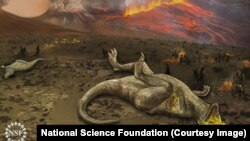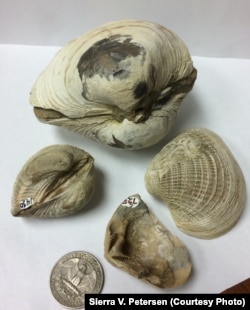In the boxing ring, a one-two punch can often mean a knock-out victory. In the great outdoors, it can mean extinction. New research suggests that's what led to the demise of the dinosaurs.
The giant reptiles ruled the earth for about 160 million years. Then, 66 million years ago, at the end of the Cretaceous Period, they disappeared.
The dinosaurs' extinction followed two catastrophic events that literally rocked their world: a huge eruption of the Deccan Traps volcanic range in what is now India that spewed poisonous levels of carbon dioxide and sulfur into the atmosphere, and then, just 150,000 years later, the crash of a 12-kilometer-wide asteroid into the coast of Mexico which threw up a cloud of dirt and rocks that blocked the sun across the globe.
Scientists have argued for decades about which of those event spelled disaster for the dinosaurs, but without a window into the past, the debate remained theoretical. Now, on an Antarctic island near the southern tip of South America, tiny fossilized clams may have provided an answer.
Separating the environmental impacts
Archeologists have found ample evidence of both the volcanic eruptions and the asteroid strike. However, with only 150,000 years separating them, layers of sediment from the two events are so close together in the rock record that it’s very difficult to distinguish the effects of one, or the other.But University of Michigan paleoclimatologist Sierra Petersen told VOA, “At Seymour Island there’s 40 meters separating those two events, so we can really separate the influences of each one and that’s why we can see the climatic impacts of both as two separate events.”
It turns out, says Andrea Dutton, now a geochemist at the University of Florida, "really [proponents of the volcano and asteroid impact theories] were both right.”
When Dutton was a graduate student at the University of Michigan, she tried to use fossilized shells from Seymour Island to study ancient climate changes. Her technique involved measuring levels of oxygen molecules in the fossils. But the numbers she came up with could be explained by both the temperature and the salt content of the water in which the shells formed. This made it difficult to interpret the results.
So the fossils got shelved until Petersen showed up with a new technique. That analysis focuses on the types of carbon molecules present in a shell, which depend strongly on the water temperature when that particular layer of shell formed.
So, for the first time, it was possible to determine the temperature record during the last days of the dinosaurs. And the record showed that things got hot. Twice.
Ancient global warming
“Preceding the impact event, at the time when the Deccan Traps volcanism in India began," Petersen explained, "we found a rapid warming spike that had not been seen before. We also found at the boundary itself when the meteorite hit ... another warming spike.”
It was the ultimate one-two punch. If the dinosaurs thought the acid rain and volcanic dust were bad, things only got worse with the rapid temperature increase that followed.
Dutton explains that the animals and plant life “had experienced temperatures this warm earlier in the Cretaceous, but what happened here was the temperature increase was so fast that it was a large stress ... they weren’t able to adapt that quickly.”
Species that survived the first warming spike were quickly - at least in geologic terms - hit by another blow -- the asteroid impact, which also caused the temperature to rise.
"We’re not necessarily saying that the warming is what killed everything at that time," Dutton stressed, "but it could have made things worse and it could have been responsible for part of that extinction."
In any case, she and co-author Petersen suggest we pay close attention to their findings, reported in Nature Communications, because the effects of rapid climate change in the Cretaceous are eerily similar to the effects scientists are seeing now from global warming.
“The volcanism preceding the meteorite impact put stress on that environment in the same way that the anthropogenic CO2 emissions we are doing now are putting on the environment today,” Petersen noted. “We are already seeing extinctions and certain organisms being under a lot of environmental stress. All of the same things we are observing today would have been in play during the Cretaceous as well.”
“So,” she added with a nervous chuckle, “fingers crossed for no meteorite impact.”














